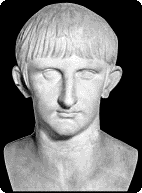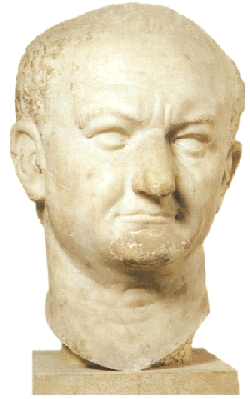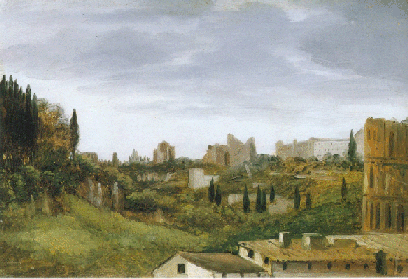Once there was a lake... The site of the Colosseum
is in fact a depression among the hills of Rome: the Palatine on its south-western side,
the Velia on the western side, the last slopes of the Esquiline hill, also called Colle
Oppio (now a park) on the northern side and the Celio on the Eastern side. The Velia,
though, has disappeared: during the thirties, the hill – which was in fact a ridge
between the Colle Oppio and the Palatine – was razed to the ground in order to build
the modern Via dei Fori Imperiali, the road that connects Piazza Venezia to
the Colosseum cutting through the forums of old Rome. Mussolini strongly wanted a straight
road from Piazza Venezia to the Colosseum, and that was the end of the Velia.
Right: Granet, The Palatine Hill
The valley collected the waters, which created a marsh or a lake, depending on the
season.
The small lake was fed by the waters of the Rio Labicano, a stream flowing down the
Labicana valley, more or less along modern Via Labicana. The stream can still be seen
underground when visiting the Church of St. Clemente in Via di San Giovanni. There
you can descend about 30 feet under modern ground level, find yourself walking on old
Roman alleys, enter shops and houses, visit a Mithraic temple and listen to the soothing
sound of running water. The stream is still there and the water runs clear and fast,
enclosed inside a drain built in the 19th century in order to drain the
underground of the Basilica.
 The emperor Nero (right) took advantage of the lake
in order to embellish his palace, the Domus Aurea
(Golden House), which occupied an enormous area in the centre of the city. Many people,
rich and poor alike, were dispossessed of their properties for the emperor to build a
house that Nero described "worthy of an human being". It is difficult to
understand the magnitude of the Domus Aurea: there were so many buildings that Nero
actually never managed to visit all the rooms of his mansion.
The emperor Nero (right) took advantage of the lake
in order to embellish his palace, the Domus Aurea
(Golden House), which occupied an enormous area in the centre of the city. Many people,
rich and poor alike, were dispossessed of their properties for the emperor to build a
house that Nero described "worthy of an human being". It is difficult to
understand the magnitude of the Domus Aurea: there were so many buildings that Nero
actually never managed to visit all the rooms of his mansion.
The lake became thus part of a huge park provided with all sorts of amenities,
including houses around the lake built in the style of sea villages. Nero also placed in
his palace a colossal bronze statue of himself (120 feet high, work of Zenodorus), whose
face was later modified many times to represent different emperors.
 After the death of Nero in 68 AD, and after a period
of turmoil, Vespasian (left) came to
power. The new emperor established a new dynasty, the Flavians, and wanted to gain
popularity with the Roman citizens, showing that the times of tyranny and despotism were
over: He made a point of giving back to the Romans the area of Nero’s Domus Aurea.
The amphitheatre then – a public building donated by the emperor to the Roman
citizens – stood on the former site of Nero’s mansion as a splendid symbol of the new political order.
After the death of Nero in 68 AD, and after a period
of turmoil, Vespasian (left) came to
power. The new emperor established a new dynasty, the Flavians, and wanted to gain
popularity with the Roman citizens, showing that the times of tyranny and despotism were
over: He made a point of giving back to the Romans the area of Nero’s Domus Aurea.
The amphitheatre then – a public building donated by the emperor to the Roman
citizens – stood on the former site of Nero’s mansion as a splendid symbol of the new political order.
The statue of Nero, called Colossus, was later dedicated by Vespasian to the God Sun,
and then moved by Hadrian near the
amphitheatre. The name Colosseum
seems therefore to come from the colossal bronze statue. Discussion among the experts is
still open, though, because some have argued that 1) there is no substantial evidence of
the presence of the statue near the amphitheatre; 2) the name Colosseum appears only from
the 11th century, when the statue had long disappeared.
 The emperor Nero (right) took advantage of the lake
in order to embellish his palace, the Domus Aurea
(Golden House), which occupied an enormous area in the centre of the city. Many people,
rich and poor alike, were dispossessed of their properties for the emperor to build a
house that Nero described "worthy of an human being". It is difficult to
understand the magnitude of the Domus Aurea: there were so many buildings that Nero
actually never managed to visit all the rooms of his mansion.
The emperor Nero (right) took advantage of the lake
in order to embellish his palace, the Domus Aurea
(Golden House), which occupied an enormous area in the centre of the city. Many people,
rich and poor alike, were dispossessed of their properties for the emperor to build a
house that Nero described "worthy of an human being". It is difficult to
understand the magnitude of the Domus Aurea: there were so many buildings that Nero
actually never managed to visit all the rooms of his mansion.
 After the death of Nero in 68 AD, and after a period
of turmoil,
After the death of Nero in 68 AD, and after a period
of turmoil,